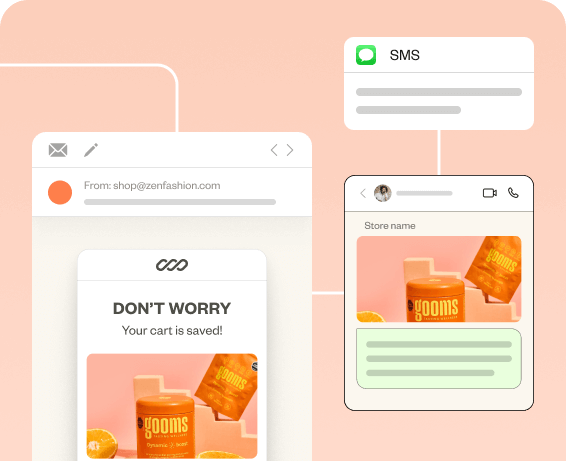Time is running out. You might have to forsake a loyal customer by the time you scan the intro. So, let’s get to the point.
Cart abandonment has always been a menace for the eCommerce sector. The cart abandonment rate is so high that every 7 out of 10 shoppers do it for varied reasons.
The title reads ‘Ways to convert abandoned cart visitors to loyal customers’.
Trace the journey of an eCommerce store visitor from the phase of cart abandonment to being a loyal customer and it would look like this.

Phase I – Abandoned Cart to Customer
This first phase is all about the abandoned cart visitor turning into a customer. Yes, with one purchase a person becomes a customer but loyalty is still far behind. Let’s discuss that in the second phase.
The reasons for cart abandonment are many like just browsing, unsatisfactory return policy. Similarly, there are four ways to curb why customers abandon shopping carts.
- Abandoned cart emails
Cart recovery emails are the first solution that every eCommerce store owner would turn to when setting out a campaign to recover lost sales. ‘No free shipping’ is one of the top reasons for shopping cart abandonment. To tackle this issue, a cart recovery email with an offer for free shipping can be sent out to the customer base.
In this way, abandoned cart emails always win when a particular issue faced by the visitor is addressed.
- Ad retargeting
Earlier, ad retargeting was applicable only to browse abandonment. Technology has advanced that the same method can be used for recovering abandoned carts too. This is possible with product-wise retargeting.
With product-wise retargeting, the abandoned product will be shown as an ad when the visitor browses other sites. This is usually accompanied with a discount to convert the visitor.
- Push notifications
Push notifications are similar to ad retargeting. They appear on any site that the visitor is browsing but the scope of a push notification is wider. In-stock alerts, abandoned cart recovery, personalized messages, and many other details can be shared via push notifications.
- Exit-intent popups
Though useful, exit-intent popups can be used only when the visitor is about to leave the site. In other words, only during one instance. They do work and convert a customer when the right customers are targeted with a suitable discount.
I reiterate. If the above four methods click, the abandoned cart visitors are converted to customers. Now, time for phase II.
Phase II – Customer to Loyal Customer
This is a phase where a customer turns loyal after repeat purchases. The crucial difference between phase I and II is that the former has an end but the latter is endless. Phase I ends with just one purchase but the second one is for a lifetime with varying levels of loyalty.
To deal with this extensive and probably exhaustive (handling a customer for a lifetime is for sure like that) phase, you will need different strategies that are detailed here.
Relax a bit and get ready for a ride. You are about to confront 10 effective strategies to make your customers loyal.
eCommerce loyalty program
Without a doubt, loyalty programs are the ones that rush to mind when on the hunt for an answer to ‘how to improve customer loyalty for an eCommerce site?’.
The essence of a loyalty program can be put in two ways – providing special and exclusive benefits to loyal customers (or) luring regular customers with benefits to turn them into loyal ones. Either way, it helps not only to cement a solid customer base but also expands it gradually over time.
eCommerce loyalty rewards are given out in many forms
- Points
- Personalized discounts
- Free products
- Contest entry
- Special invite to a product launch
- Early notification for a sale
In most cases, the above-given customer loyalty program ideas are used in combination to make it far more effective. One of the successful loyalty programs examples is from e.l.f. They have a tiered program as shown in the image below.
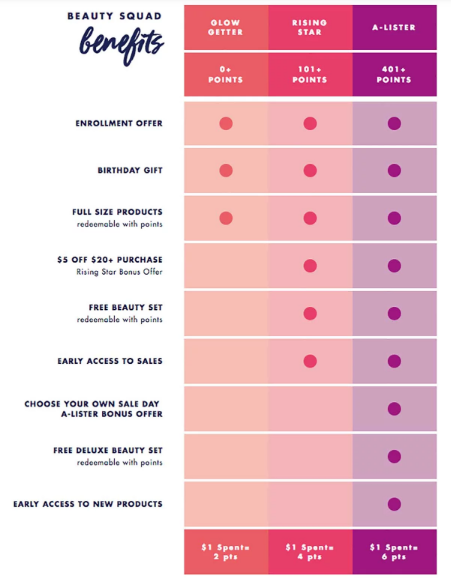
Takeaways:
- Brilliant naming of tiers – Glow Getter, Rising Star, A-Lister.
- Points that increase 2x and 3x with each dollar spent.
- Clarity on the rewards that are available to each tier.
It is very much noticeable that the benefits increase with each level. Exclusivity is offered. This motivates the customer to work more towards being loyal. In other words, any person miffed with beauty would do anything to get to the highest level.
Start a referral program
What are referrals?
I must say referrals are the digitized form of word-of-mouth advertising.
Do they work?
Oh, yes! Here is proof.
Research by HubSpot reveals that 81% of people trust recommendations from family and friends compared to companies.
A referral program is a spin-off of a loyalty program with an added benefit. It is a way of growing the audience base with the help of customers themselves. Similar to a loyalty program, rewards are given here but a new customer gets added too.
Here is an example by Thrive Causemetics that is powered by Referral Candy.
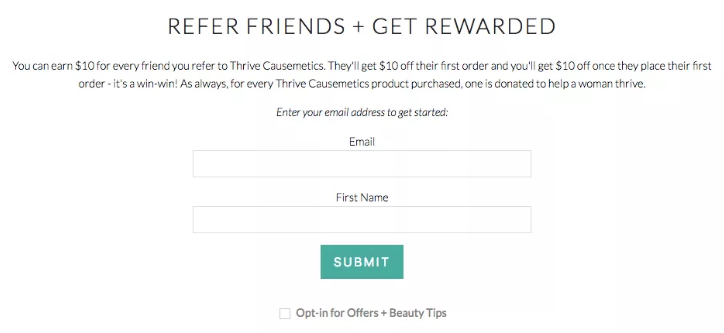
Thrive is an eCommerce store that sells cosmetic products for women. They have a separate page on the website to initiate a referral and the reward is double-edged. Both the friend and the customer gets a $10 off each for the next purchase they make.
The company has generated a 2.38% of revenue from referrals.
Takeaway: The advocate returns for another purchase from time to time along with the referred friends.
Other ways in which referral programs can be introduced are given below.
- As a post-purchase popup.
- As a referral email.
- Use social media to share referrals.
Send transactional emails with coupon code
This is one of the simplest ways of how to retain your eCommerce customers’ loyalty. Sending out a transactional email is the first step to do after the customer makes a purchase, especially when it is from a cart recovery email.
The catch is that the transactional email must contain a coupon code to drive repeat sales. Repeat sales is what will create loyalty. So, leverage this situation to achieve it.
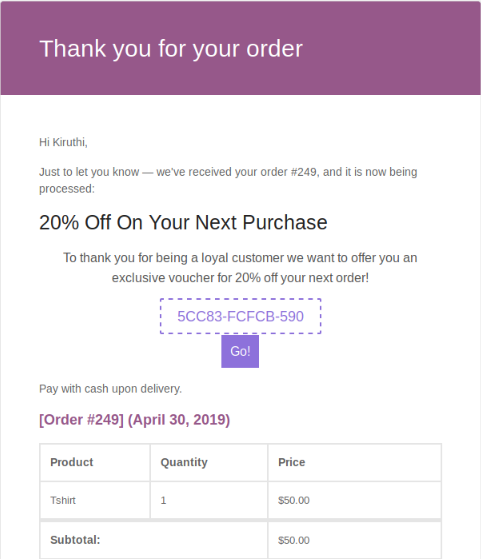
Retainful provides you with the option to generate next order coupons with transactional emails so that the customer comes back again to your store for the next purchase. The coupon gets automatically added to the cart when the next purchase is made.
Takeaway: Transactional email is the best way to keep in touch with the customer after a purchase. Apply a countdown timer to the coupon code to make it more compelling.
Create urgency with push notifications
A sale can be completed using a push notification too. Creating urgency and demand is one sales tactic that can be implemented here. This is return builds customer loyalty over time.
Product in demand can be highlighted by showing low stock count, a time period can be mentioned to avail an offer, or even better, a countdown timer can be put in place. One advantage push notification has is that the same message can be delivered across all devices – mobiles, desktops, and tablets.
Takeaway: Do not overdo the urgency technique because it might seem obvious and forces. Combine it with other strategies like product recommendations in the customer loyalty campaign.
eCommerce email marketing
Of course, the power of emails can never be ignored for marketing purposes. Email is the medium that has even wider usage than social media. So, when used wisely, email marketing gives good results.
Abandoned cart emails are also part of email marketing but as mentioned before, making a purchase after a shopping cart abandonment turns a visitor into a customer. Further emails must follow to make him a loyal one.
How to follow-up after a cart recovery email?
When the purchase has been made
- A transactional email with coupon code
- Thank you email with product recommendations
- Product review email with a reward
When there is no purchase
- Find out the reason for not purchasing, rectify issues if any.
- Nudge again after a few months.
Dollar Shave Club asks customers why they won’t make a purchase again.

When one DSC club member chose the option ‘I’m growing it out’, the company nailed it when they sent another email after a few months asking ‘How’s that beard coming?’.
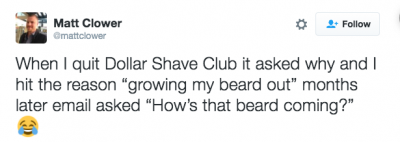
This is the exact way to hold on to the customers in your kitty. Loyalty is gained here as a result of the effort put in.
Takeaway: Just don’t let go off a customer just because he is uninterested. As long as he remains subscribed, keep nudging once in a while.
Narrow down the target audience
This is rather a tip than a proven way to build customer loyalty.
Check out the following scenario.
First instance – 1 teacher and 60 pupils
Second instance – 1 teacher and 20 pupils
Which instance do you think will give a better output, both from students and the teacher?
I would say the second. The logic is simple here. The teacher will be able to give special attention to specific needs of all the 20 children. This would be a difficult task when the number is high
The same applies to building eCommerce customer loyalty.
Gone are the days of ‘batch and blast’ approach. ‘Segmented targeting’ is the word I propose here instead.
Eliminate the old ways of marketing the same content to your whole customer base. The preferences and expectations of most customers are not met here. Alternatively, target them after a segmenting them based on a criteria.
To build loyalty, customers can be segmented based on
- Average purchase amount
- Product preference
- Browsing behaviour, etc.
Post segmentation, get to know the problems and needs of each segment that hinders them from being a loyal customer. Rectify that problem and get them back with a marketing strategy that cannot be ignored.
Takeaway: By targeting, the customer tends to get VIP treatment from the eCommerce store and hence will never want to purchase elsewhere.
Never compromise on product quality
A survey by Zendesk revealed that 88% of customers gave priority to product quality as one of the reasons for showcasing loyalty.
It must be the prime duty of an eCommerce store to keep regular checks on the quality of products. It is pretty common to see situations nowadays where people post snaps of the product ordered and the one received.
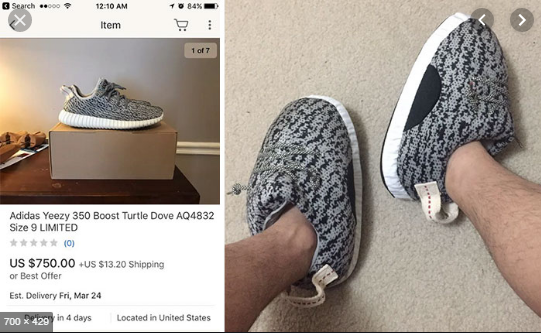
Once this happens, people are never going to return to your eCommerce store, no matter what. Made, a furniture dealer in the UK gives an example of how to uphold product quality.
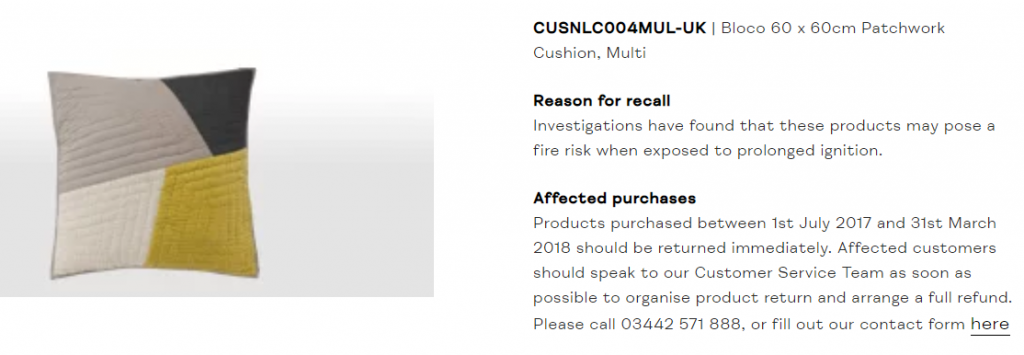
They have a separate page on their website for product recall and the reason they quote is ‘products fall short of our high quality and safety standards’. Quite some time back the company had to recall a number of cushions that posed a fire risk. This one small act of theirs shows the importance they give to product quality.
Takeaway: Pictures are what people rely on when purchasing online. So, post the right pictures and deliver a product of the same quality.
Connect personally
Personal attention is the need of the hour to pep up your eCommerce game. When I say personal, it is not just about mentioning the customers’ names in the emails. There is more to giving a personalized shopping experience.
Ways in which shopping can be personalized are given below.
- Showing product recommendations as per purchase history
- Sending out birthday and anniversary emails to customers with discounts
- Using a survey to create user-generated content to connect better
- Reaching out in times of trouble via live chat or email
Here is one way to make people feel special.
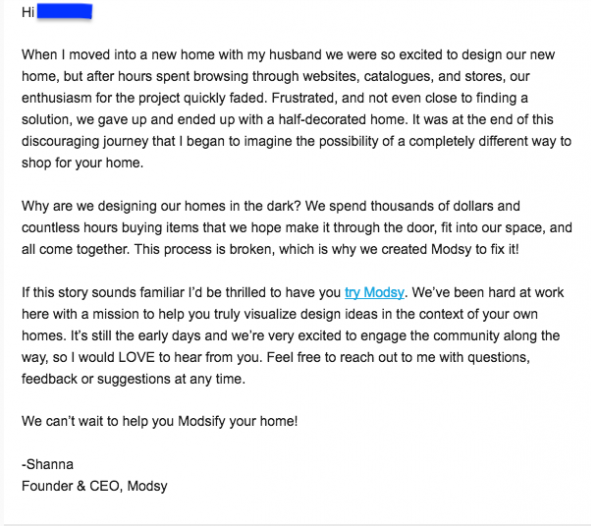
This email was sent by the CEO of Modsy to one of their customers. Can that be true? The email team uses her name. That’s it. The difference this move can make is huge.
Modsy is an eCommerce store that sells out stuff to decorate interiors of houses and this email clearly outlays the struggles the CEO herself went through while looking for a good place to buy decoratives online. An emotional connect is established here with the customer and the use of just plain and casual language only strengthens it.
Takeaway: Sell value, not the product.
Optimize your mobile eCommerce
The presence of disturbing elements in a mobile eCommerce page that leads to slow loading can irk your customer, even if he is a loyal one. This is a must because the number of mobile users has surpassed desktops and is set to grow to a higher value in the future.
Faster loading time is the need of the hour and there is nothing to beat it.
Takeaway: Start mobile optimization right now.
Build a community for a cause
eCommerce loyalty platforms are not anymore a mere place to boast about customer loyalty. It is more about uniting as a community to address a social cause.
The loyalty program by TOMS, a footwear store, does it this way. There are no monetary benefits or rewards involved. What do they offer then?
They provide resources to bring about a global change. One example is the One for One shoe donation. When a shoe is purchased, another pair is donated by the company. With this alone, TOMS has donated over 35 million shoes to 70 countries. That is huge.
Takeaway: Get to know the social cause that your customers are interested in. Develop a program around this so that the values of the store and customer base never contradict.
Closing Thoughts
Loyalty stays if it is hard-earned.
Do not stick to the old school methods to garner a loyal following.
Rather, go with the mood swings of your customer base.
Yes. I mean it.
Laugh when they laugh. Cry when they cry. Lend a shoulder in times of trouble.
This is the only way to stay afloat and soar higher in the eCommerce sector.
